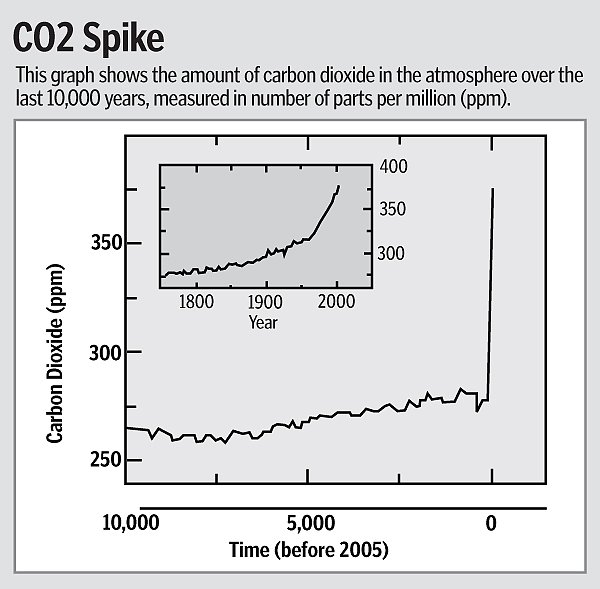Editor’s Note: This is the final column in a three-part series on energy and climate.
Part 1 outlined an energy future that would, by 2050, be based nearly entirely on efficiency and renewables such as solar.
It’s doable, and it’s cheapest, but it’s probably too smart for our antiintellectual nation.
Part 2 outlined a dumber plan that would still work: get dirtier energy from nuclear power plants and fossil fuel plants that utilize carbon dioxide (CO2) capture and storage. Here, I’ll discuss what happens if we can’t get our brains and our politics around some combination of energy futures 1 and 2.
Under this “business as usual” case, global warming will probably be sufficient to usher in a new geological age by 2100. I’ll present three arguments for this conclusion, any one of which should persuade a rational person that global warming is real, caused by humans, and likely to produce massive effects.
First, a common sense argument: Even most “climate skeptics” who think global warming is a hoax agree that fossil fuels have raised the atmospheric CO2 content by 40 percent since 1800. As you can see from the sharp spike in the graph that accompanies this article, this increase has been large, sudden, and unprecedented during the past 10,000 years.
The longer geological record shows the present CO2 level to be unprecedented during 800,000 years. And everybody agrees that CO2 is one of the “greenhouse gases” that absorb infrared energy, warming the planet. So why, as Nobelprize-winning physicist Burton Richter asks in his book “Beyond Smoke and Mirrors,” wouldn’t you expect the temperature to increase? And sure enough, the planet’s temperature has increased by 1.4 degrees Fahrenheit since 1860. Ice is melting in the Arctic ocean, in Greenland, and in mountain glaciers. Sea levels are rising, and accelerating.
Just as one would expect from the additional atmospheric energy, there’s been an increase in extreme weather such as we’ve recently experienced here: downpours, floods, tornadoes, hurricanes, heat strokes, droughts, andaccompanying forest fires.
Second, an argument from the standard scientific process: Scientists are able to use well tested scientific theories together with powerful computers to predict future climate patterns and understand past patterns.
When we apply these computer models to the past century, we find that the models agree with observed temperature trends and other data if human CO2 emissions are included in the input to the models, but do not agree with observations if these human emissions are not included in the models.
The scientific conclusion is that, with high probability, human CO2 emissions are at least a partial cause of the observed temperature increase.
Third, and most ominously, an argument from geological history: Two excellent books - James Hansen’s “Storms of my Grandchildren” and Bryan Lovell’s “Challenged by Carbon” - have emphasized the relevance of the “Paleocene-Eocene Thermal Maximum” (PETM) to the recent warming. The PETM is a global temperature rise of 8 degrees occurring 55 million years ago that ended the Paleocene geological era and initiated the Eocene era.
Studies of underwater rock layers show that the PETM was caused by 1,000 billion tons of carbon released from the ocean floor into theatmosphere. This natural, but geologically unique, release was probably triggered by a slight natural warming of a portion of the ocean that in turn warmed the methanecontaining ices that can form on the ocean floor.
This would cause the ices to suddenly emit their methane (a greenhouse gas), which entered, and warmed, the atmosphere. This caused the release of CO2, just as a warmed carbonated drink emits CO2 bubbles, causing further warming, and so forth in a vicious circle.
Today we’re well on the way to a repeat of the PETM event, caused this time by humans. Since 1900 AD, we have managed to inject 300 billion tons of carbon into the atmosphere. That’s onethird of the way toward the level that caused the PETM.
Under business as usual, we will have injected the amount that caused the PETM by 2100. But long before then, warming could melt the methane ices residing on the ocean floor, initiating the vicious circle that triggered the PETM.
The PETM raised ocean levels by 18 feet, acidified all the oceans, drastically changed animal life, and initiated a new and distinctively different geological age. CO2 levels remained significantly above normal for 170,000 years.
We’ve playing with fire, folks. To help us think about this problem, come to a discussion of books about global warming, at Fayetteville’s Omni Center, 3274 Lee Ave. (off College Avenue, near Liquor World) this Friday, May 20, at 6:30 p.m.
ART HOBSON IS A PROFESSOR EMERITUS OF PHYSICS AT THE UNIVERSITY OF ARKANSAS.
Opinion, Pages 15 on 05/15/2011

